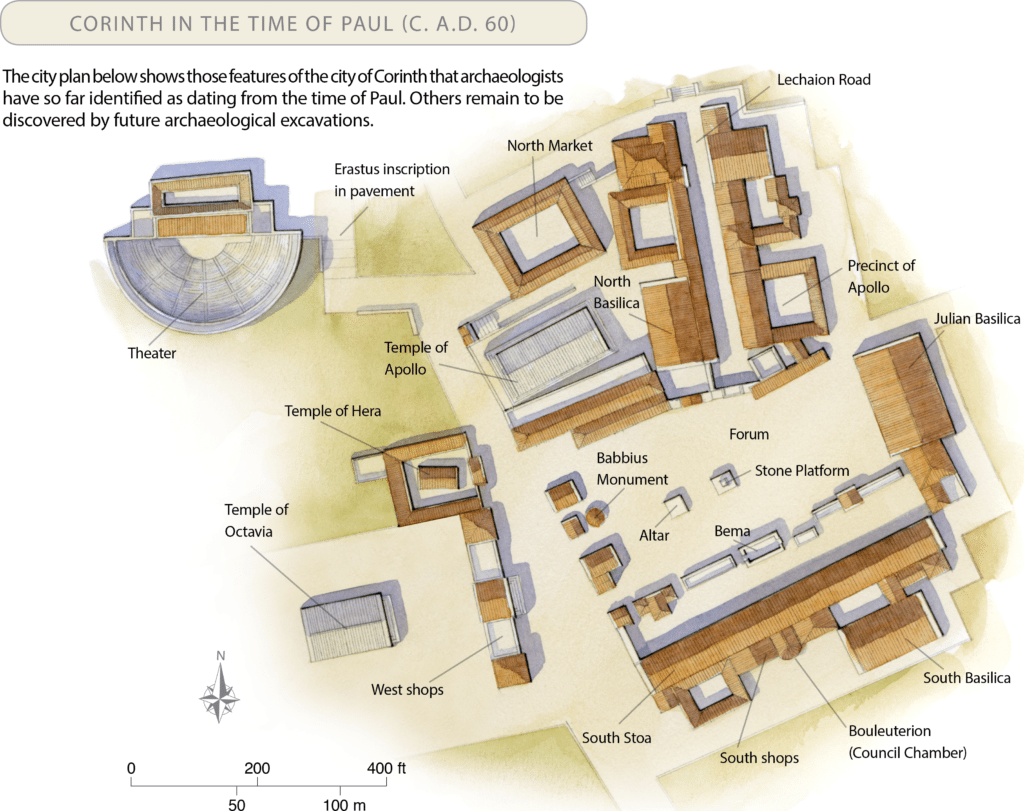Background
Corinth sat on the isthmus connecting the Greek mainland with the Peloponnesian peninsula. This location made it a flourishing crossroads for sea traffic between the Aegean region and the western Mediterranean. It was a place where many cultures and religions mingled. Since it was a Roman colony, Roman law and customs were important, particularly among the upper classes, but “many ‘gods’ and many ‘lords’ ” found a home in Corinth (1 Cor. 8:5). The worship of these gods was fully integrated into governmental affairs, civic festivals, trade guilds, and social clubs, and everyday life in general. Corinth was also a destination for traveling professional orators who charged a fee for attendance at their entertaining rhetorical displays and advised people on how to advance socially.
Into this milieu Paul brought the gospel of Jesus Christ, and soon a church was established. He was aided in his work by two new-found friends from Rome, Priscilla and Aquila, who, like Paul, were displaced Jews and tentmakers by trade (Acts 18:1–4, 18–19, 24–28; Rom. 16:3; 2 Tim. 4:19). Paul, Priscilla, and Aquila spent 18 months in Corinth in the early 50s and then, after a brief trip to Judea and Syria, Paul traveled to Ephesus. Priscilla and Aquila were already there (Acts 18:19; 1 Cor. 16:19) and, by the time Paul arrived, they had already met the skillful Christian apologist Apollos, who had also been in Corinth (Acts 18:24–19:1; 1 Cor. 1:12; 3:4–6, 22; 4:6; 16:12).
Paul settled in Ephesus for three years (Acts 20:31) and at some point wrote to the Corinthians the otherwise unknown letter that he mentions in 1 Corinthians 5:9. It is not known what prompted the letter but it dealt with sexual immorality, a persistent problem for the Corinthian church (1 Cor. 5:1–13; 6:12–20). Sometime later, Paul received an oral report indicating that the Corinthians had not only misunderstood his first letter (1 Cor. 5:10) but were plagued with serious problems of division, sexual immorality, and social snobbery (1 Cor. 1:10; 5:1; 11:18). Around the same time, a letter arrived from the Corinthians that displayed considerable theological confusion about marriage, divorce, participation in pagan religions, order within corporate worship, and the bodily resurrection of Christians (1 Cor. 7:1; 8:1; 12:1; 15:12, 35).
In response to these troubling developments, Paul felt compelled to write a substantial letter to Corinth, making the case that much of their conduct was out of step with the gospel. At the root of their disunity lay an arrogance (1 Cor. 3:21; 4:6, 8, 18–19; 5:2, 6) that was incompatible with God’s free gifts to them in Christ: wisdom, righteousness, sanctification, and redemption (1 Cor. 1:30; 4:7). In addition, a self-centered insistence on their own rights (1 Cor. 6:12; 8:9; 9:12; 10:23) at the expense of the weak (1 Cor. 8:10; 11:22) and marginalized (1 Cor. 14:16, 23) revealed that their own social advancement rather than the gospel’s advancement was their top priority.
At the root of much of the immorality and idolatry in Corinth, moreover, lay a lack of appreciation for the holiness that God requires of his people. Though the particulars of the Mosaic law were no longer to define the boundaries for God’s people (1 Cor. 7:19), the law’s underlying theme that God’s people were to be “set apart”—a people marked off from their culture—remained in place (1 Cor. 5:1–2, 13; 7:19; 10:1–5). In addition, the dwelling of God’s Spirit within each believer (1 Cor. 6:19) and the new unity that believers have with the resurrected, living Christ (1 Cor. 6:14–17; 15:30–34) implied that the Corinthians needed to make a clean break from the moral impurity of their culture.
Despite the often stern tone of the letter (1 Cor. 4:18–21; 5:2; 11:17, 22; 15:36), Paul was thankful to God for the Corinthians (1 Cor. 1:8) and felt a deep personal affection for them (1 Cor. 16:24). Because of this love, and for the purpose of God’s glory (1 Cor. 10:31), Paul wanted the Corinthians to become a well-constructed dwelling place for God’s Spirit (1 Cor. 3:12, 16) and to be “guiltless in the day of our Lord Jesus Christ” (1 Cor. 1:8).










